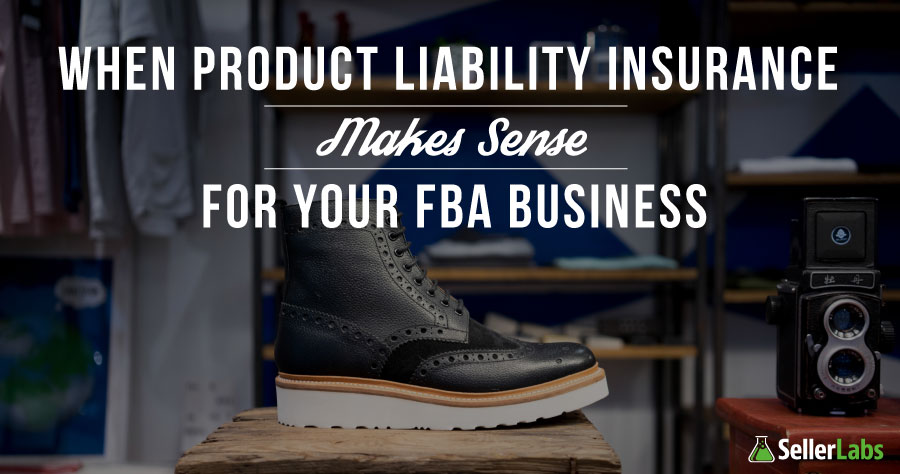When Product Liability Insurance Makes Sense for your Amazon FBA Business

Importing products from Chinese manufacturers to fuel private label Amazon FBA business has become the preferred strategy for many sellers over the past 18 months. As simple as many sellers may make it seem to start this kind of business, there are many unseen nuances involved that can stall sellers and their products quickly—product liability resulting in the most serious issues. Like if a customer were to be injured or killed, or if their house was destroyed by an imported hover board, as happened in late 2015.
What is product liability?
Cornell University Law School defines product liability as:
Any or all parties along the chain of manufacture of any product for damage caused by that product. This includes the manufacturer of component parts, an assembling manufacturer, the wholesaler, and the retail store owner.
Manufacturing defects are the most common reason for product liability issues. If your product has an issue, you’ll be more than likely stuck holding the bag if it was manufactured in China, especially if the manufacturer has no domestic presence in your country. Ultimately, the importer and manufacturer should be responsible for the safety of products.
You can avoid costly headaches and danger by establishing a comprehensive compliance program. In the example of the hover board, the factories who ensured the safety of their products through product testing and certification not only didn’t cause homes to burn down or injure customers, but they were allowed to re-list almost immediately after Amazon removed all hover boards from its website pending a safety review. However, to further protect yourself you should consider insurance.
What can you do to protect yourself?
Begin with getting Commercial General Liability (CGL) insurance. Most sellers have this insurance to protect them against liability claims. You can get CGL insurance for a relatively low premium. A CGL plan should be adequate until your business starts selling about $300,000 worth of product annually. Once you’re at this threshold you’ll want to increase your coverage with product liability insurance.
Product liability insurance is expensive and you need to weigh the pros and cons of getting it. Such as:
- Are you able to afford product liability insurance (do you make more than $300,000 in annual revenue)?
- Do you have enough to lose to justify the insurance premium?
Product liability insurance won’t make sense for the majority of Amazon sellers. Make sure to double check all of your compliance requirements before purchasing this insurance—it is preferable to have a minor unforeseen issue than an easily foreseen issue that could destroy your business in legal fees. Amazon buys an individual policy for each new product it launches. It’s one of the reasons why Amazon targets products making more than $100,000 per month in revenue, because the tenets of the brand require a quick ROI turnaround. As a smaller seller than Amazon, however, you probably won’t have deep enough pockets to purchase this insurance for every new product you buy.
Product liability insurance helps protect you if your product injures or could have the potential to injure a customer. Understanding your product from a regulatory and safety perspective, and having a comprehensive compliance program, to prevent potential injury in the first place will do more to keep you out of hot water than insurance. Plus, it shouldn’t cost you more than $10,000 per year. And if you don’t have a compliance program in place and neglect to report any issues to the Consumer Product Safety Commission (CPSC), it is likely that they will fine you in addition to any lawsuits. The requirement to produce a safety and compliant product exists with or without insurance.
The Double LLC Strategy
If you’re a new seller or are below the $300,000 annual revenue mark, and you want to experiment with importing new products, there’s another way to protect yourself. We’ll call it the Double LLC Strategy: one LLC for high-risk products and another one for low-risk products. Use the high-risk LLC as the importer of record for items and use your Amazon seller account as a third entity.
Once you get an item large enough to justify the cost and effort, say around $100,000 in revenue, move it from the high-risk LLC to the low-risk LLC and then purchase product liability insurance. The logic with this plan is to shift the liability to the LLC that is legally responsible for importing the product. This will make the high-risk LLC responsible to pay for the problem or bankrupt it without impacting your other businesses. Before pursuing a strategy like this you absolutely need to speak with an attorney who has experience with importing and product liability. Amazon structures its businesses in a similar manner. It helps them manage their tax burdens and other legal obligations to have a fragmented business structure. But you want to make sure your plan is watertight by reviewing with your insurance agent and attorney before taking this approach.
Key takeaway
An ounce of prevention through compliance is worth a pound of cure through insurance. Take all of the necessary steps to create a thorough prevention program before launching a product on Amazon. Once you start getting some real traction, then consider purchasing a product liability insurance plan. Either way, you can’t go wrong with a Commercial General Liability insurance plan to cover your business until you start earning $300,000 and up in revenue.
Rachel Greer was a contributing author on this blog post.

Jeff has more than 15 years of eCommerce experience. He is the Principal Evangelist of Advertising API at Amazon and a frequent keynote speaker at various business related conferences. He's widely regarded as an industry expert who is asked to share actionable intelligence on how Amazon works and how sellers can improve their business.






